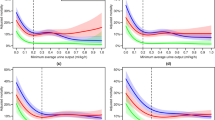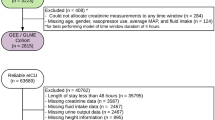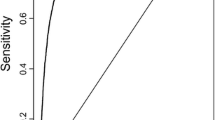Abstract
Purpose
The observation periods and thresholds of serum creatinine and urine output defined in the Acute Kidney Injury Network (AKIN) criteria were not empirically derived. By continuously varying creatinine/urine output thresholds as well as the observation period, we sought to investigate the empirical relationships among creatinine, oliguria, in-hospital mortality, and receipt of renal replacement therapy (RRT).
Methods
Using a high-resolution database (Multiparameter Intelligent Monitoring in Intensive Care II), we extracted data from 17,227 critically ill patients with an in-hospital mortality rate of 10.9 %. The 14,526 patients had urine output measurements. Various combinations of creatinine/urine output thresholds and observation periods were investigated by building multivariate logistic regression models for in-hospital mortality and RRT predictions. For creatinine, both absolute and percentage increases were analyzed. To visualize the dependence of adjusted mortality and RRT rate on creatinine, the urine output, and the observation period, we generated contour plots.
Results
Mortality risk was high when absolute creatinine increase was high regardless of the observation period, when percentage creatinine increase was high and the observation period was long, and when oliguria was sustained for a long period of time. Similar contour patterns emerged for RRT. The variability in predictive accuracy was small across different combinations of thresholds and observation periods.
Conclusions
The contour plots presented in this article complement the AKIN definition. A multi-center study should confirm the universal validity of the results presented in this article.


Similar content being viewed by others
References
Chertow GM, Burdick E, Honour M, Bonventre JV, Bates DW (2005) Acute kidney injury, mortality, length of stay, and costs in hospitalized patients. J Am Soc Nephrol 16:3365–3370. doi:10.1681/ASN.2004090740
Barrantes F, Tian J, Vazquez R, Amoateng-Adjepong Y, Manthous CA (2008) Acute kidney injury criteria predict outcomes of critically ill patients. Crit Care Med 36:1397–1403. doi:10.1097/CCM.0b013e318168fbe0
Cruz DN, Bolgan I, Perazella MA et al (2007) North East Italian Prospective Hospital Renal Outcome Survey on Acute Kidney Injury (NEiPHROS-AKI): targeting the problem with the RIFLE Criteria. Clin J Am Soc Nephrol 2:418–425. doi:10.2215/CJN.03361006
Hoste EA, Clermont G, Kersten A, Venkataraman R, Angus DC, De Bacquer D, Kellum JA (2006) RIFLE criteria for acute kidney injury are associated with hospital mortality in critically ill patients: a cohort analysis. Crit Care 10:R73. doi:10.1186/cc4915
Ostermann M, Chang R, Riyadh ICU Program Users Group (2008) Correlation between the AKI classification and outcome. Crit Care 12:R144. doi:10.1186/cc7123
Kellum JA, Levin N, Bouman C, Lameire N (2002) Developing a consensus classification system for acute renal failure. Curr Opin Crit Care 8:509–514
Mehta RL, Kellum JA, Shah SV et al (2007) Acute Kidney Injury Network: report of an initiative to improve outcomes in acute kidney injury. Crit Care 11:R31. doi:10.1186/cc5713
Bellomo R, Ronco C, Kellum JA, Mehta RL, Palevsky P, Acute Dialysis Quality Initiative workgroup (2004) Acute renal failure—definition, outcome measures, animal models, fluid therapy and information technology needs: the Second International Consensus Conference of the Acute Dialysis Quality Initiative (ADQI) Group. Crit Care 8:R204–R212. doi:10.1186/cc2872
Smith GL, Vaccarino V, Kosiborod M, Lichtman JH, Cheng S, Watnick SG, Krumholz HM (2003) Worsening renal function: what is a clinically meaningful change in creatinine during hospitalization with heart failure? J Card Fail 9:13–25. doi:10.1054/jcaf.2003.3
Lassnigg A, Schmidlin D, Mouhieddine M, Bachmann LM, Druml W, Bauer P, Hiesmayr M (2004) Minimal changes of serum creatinine predict prognosis in patients after cardiothoracic surgery: a prospective cohort study. J Am Soc Nephrol 15:1597–1605
Joannidis M, Metnitz B, Bauer P, Schusterschitz N, Moreno R, Druml W, Metnitz PG (2009) Acute kidney injury in critically ill patients classified by AKIN versus RIFLE using the SAPS 3 database. Intensive Care Med 35:1692–1702. doi:10.1007/s00134-009-1530-4
Kidney Disease: Improving Global Outcomes (KDIGO) Acute Kidney Injury Work Group (Suppl. 2012) KDIGO Clinical Practice Guideline for Acute Kidney Injury. Kidney Int 2:1–138
Prowle JR, Liu YL, Licari E et al (2011) Oliguria as predictive biomarker of acute kidney injury in critically ill patients. Crit Care 15:R172. doi:10.1186/cc10318
Thakar CV, Christianson A, Freyberg R, Almenoff P, Render ML (2009) Incidence and outcomes of acute kidney injury in intensive care units: a Veterans Administration study. Crit Care Med 37:2552–2558. doi:10.1097/CCM.0b013e3181a5906f
Ishani A, Nelson D, Clothier B et al (2011) The magnitude of acute serum creatinine increase after cardiac surgery and the risk of chronic kidney disease, progression of kidney disease, and death. Arch Intern Med 171:226–233. doi:10.1001/archinternmed.2010.514
Bellomo R, Kellum JA, Ronco C (2004) Defining acute renal failure: physiological principles. Intensive Care Med 30:33–37. doi:10.1007/s00134-003-2078-3
Saeed M, Villarroel M, Reisner AT et al (2011) Multiparameter Intelligent Monitoring in Intensive Care II: a public-access intensive care unit database. Crit Care Med 39:952–960. doi:10.1097/CCM.0b013e31820a92c6
Mandelbaum T, Scott DJ, Lee J et al (2011) Outcome of critically ill patients with acute kidney injury using the Acute Kidney Injury Network criteria. Crit Care Med 39:2659–2664. doi:10.1097/CCM.0b013e3182281f1b
Vincent JL, Moreno R, Takala J et al (1996) The SOFA (Sepsis-related Organ Failure Assessment) score to describe organ dysfunction/failure. On behalf of the Working Group on Sepsis-Related Problems of the European Society of Intensive Care Medicine. Intensive Care Med 22:707–710
Elixhauser A, Steiner C, Harris DR, Coffey RM (1998) Comorbidity measures for use with administrative data. Med Care 36:8–27
Picard RR, Cook RD (1984) Cross-validation of regression models. J Am Stat Assoc 79:575–583
Acknowledgments
This research was supported in part by Grant R01 EB001659 from the National Institute of Biomedical Imaging and Bioengineering (NIBIB) of the National Institutes of Health (NIH). Dr. Joon Lee also holds a Postdoctoral Fellowship from the Natural Sciences and Engineering Research Council of Canada (NSERC).
Conflicts of interest
None of the authors have any financial interests or potential conflicts to disclose.
Author information
Authors and Affiliations
Corresponding author
Additional information
T. Mandelbaum and J. Lee contributed equally to this work.
This article is discussed in the editorial available at: doi:10.1007/s00134-012-2768-9.
Electronic supplementary material
Below is the link to the electronic supplementary material.
Rights and permissions
About this article
Cite this article
Mandelbaum, T., Lee, J., Scott, D.J. et al. Empirical relationships among oliguria, creatinine, mortality, and renal replacement therapy in the critically ill. Intensive Care Med 39, 414–419 (2013). https://doi.org/10.1007/s00134-012-2767-x
Received:
Accepted:
Published:
Issue Date:
DOI: https://doi.org/10.1007/s00134-012-2767-x




